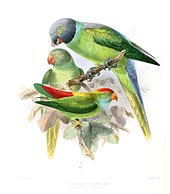Blue-tailed Parakeet
| Blue-tailed Parakeet | ||||||||||||
|---|---|---|---|---|---|---|---|---|---|---|---|---|

Female of the blue-tailed parakeet on a pineapple |
||||||||||||
| Systematics | ||||||||||||
|
||||||||||||
| Scientific name | ||||||||||||
| Psittacula calthropae | ||||||||||||
| ( Blyth , 1849) |
The Blauschwanz parakeet ( Psittacula calthropae , Syn. : Psittacula calthrapae ), also called Blauschwanz Lovebird referred to is a parrot from the kind of noble parakeets ( Psittacula ). It is native to Sri Lanka . The art epithet honors Barbara Anne Calthrop, the first wife of ornithologist Edgar Leopold Layard (1824–1900).
features

The blue-tailed parakeet reaches a size of 29 to 31 cm. In the male, the upper bill is red with a yellowish tip, the lower bill is dull brownish. The forehead and the area around the eyes to the lower beak are pale green. The rest of the head is blue-gray with a black area on the chin and sides of the neck. A wide emerald green band runs around the neck and on the bottom. The back, coat and rump are blue-gray. The wings are dull green. The small elytra are grayish, the middle ones are yellowish. The tail feathers are deep gray-blue with yellow tips. The female has a gray-black beak. In the juvenile birds, the gray hues are replaced by a green color. Both the upper and lower beak are orange-red.
habitat
The habitat is wooded hills and clearings at altitudes up to 2000 m. At sea level, it can only be seen in the wet zone in southwest Sri Lanka.
Way of life
The main diet of the blue-tailed parakeet consists of the fruits of Macaranga tanarius , wild figs and wild cinnamon . In addition, the papaya flowers , buds and nectar enrich the food supply. In heavily forested habitats , the food is less granular . The breeding season is between January and May and often again between July and September. The nest is usually built 10 to 25 meters above the ground in a hollow branch or in a tree hole. Preferred breeding trees are Pterocarpus , Syzygium and Terminalia . Two to four eggs are laid. In human care, the incubation takes about three weeks. After seven weeks the young birds leave the nest. Blue-tailed parakeets are evidently resident birds. Occasionally, seasonal migrations can occur.
nomenclature
In 2003, Edward C. Dickinson changed the epithet spelling calthropae due to its predominant use in calthorpae . Edgar Leopold Layard, however, clearly stated that the spelling calthropae , which is dedicated to his first wife, should be retained. According to the ICZN's Principle of Priority, the spelling calthropae is correct and Dickinson's spelling is only an invalid synonym spelling.
Individual evidence
- ↑ Dickinson, Edward C., ed. 2003. The Howard and Moore Complete Checklist of the Birds of the World, 3rd Edition
literature
- Joseph M. Forshaw: Parrots of the World: An Identification Guide . Princeton University Press, Princeton, New Jersey, and Woodstock, United Kingdom, 2006. ISBN 978-0-691-09251-5
- Del Hoyo, J., Elliot, A. & Sargatal, J. (Editors) (1997). Handbook of the Birds of the World. Volume 4: Sandgrouse to Cuckoos . Lynx Edicions. ISBN 8487334229
Web links
- Lexicon of Parrots
- Photos at Oriental Bird Images
- Psittacula calthrapae inthe IUCN Red List of Threatened Species 2013.1. Listed by: BirdLife International, 2012. Retrieved September 26, 2013.